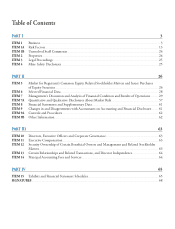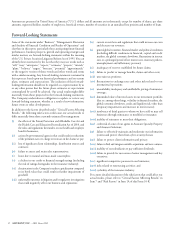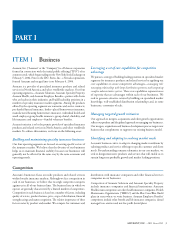Assurant 2011 Annual Report Download - page 18
Download and view the complete annual report
Please find page 18 of the 2011 Assurant annual report below. You can navigate through the pages in the report by either clicking on the pages listed below, or by using the keyword search tool below to find specific information within the annual report.
ASSURANT, INC.2011 Form10-K10
PARTI
ITEM 1 Business
Enterprise Risk Management
As an insurer, we are exposed to a wide variety of nancial, operational
and other risks, as described in Item1A, “Risk Factors.” Enterprise risk
management (“ERM”) is, therefore, a key component of our business
strategies, policies, and procedures. Our ERM process is an iterative
approach with the following key phases:
1. Risk identi cation;
2. High-level estimation of risk likelihood and severity;
3. Risk prioritization at the business and enterprise levels;
4. Scenario analysis and detailed modeling of likelihood and severity
for key enterprise risks;
5. Utilization of quantitative results and subject matter expert
opinion to help guide business strategy and decision making;
rough our ERM process and our enterprise risk quanti cation model
we monitor a variety of risk metrics on an ongoing basis, with a particular
focus on impact to net income (both GAAP and Statutory), company
value and the potential need for capital infusions to subsidiaries under
severe stress scenarios.
e Company’s ERM activities are coordinated by an Enterprise
Risk Management Committee (“ERMC”), which includes managers
from across the Company with knowledge of the Company’s business
activities, including representation from Legal, Compliance, Actuarial,
Audit, Finance, and Asset Management. e ERMC develops risk
assessment and risk management policies and procedures. It facilitates
the identi cation, reporting and prioritizing of risks faced by the
Company, and is responsible for promoting a risk-aware culture
throughout the organization. e ERMC also coordinates with each of
the Company’s four Business Unit Risk Committees (“BURCs”), which
meet regularly and are responsible for the identi cation of signi cant
risks a ecting their respective business units. ose risks which meet
our internally-de ned escalation criteria, including emerging risks, are
then reported to the ERMC.
Our Board of Directors and senior management are responsible for
overseeing signi cant enterprise risks. e ERMC reports regularly to
the Chief Executive O cer and presents its work periodically to both
the Board of Directors and the Finance and Investment Committee.
rough the use of regular committee meetings, business unit and
enterprise risk inventory templates, risk dashboards, hypothetical
scenario analysis, and quantitative modeling, the Company strives
to identify, track, quantify, communicate and manage our key risks
within prescribed tolerances.
Our ERM process continues to evolve, and, when appropriate, we
incorporate methodology changes, policy modi cations and emerging
best practices on an ongoing basis.
Regulation
e Company is subject to extensive federal, state and international
regulation and supervision in the jurisdictions where it does business.
Regulations vary from jurisdiction to jurisdiction. e following is a
summary of signi cant regulations that apply to our businesses and
is not intended to be a comprehensive review of every regulation to
which the Company is subject. For information on the risks associated
with regulations applicable to the Company, please see Item1A, “Risk
Factors.”
U.S. Insurance Regulation
We are subject to the insurance holding company laws in the states
where our insurance companies are domiciled. ese laws generally
require insurance companies within the insurance holding company
system to register with the insurance departments of their respective
states of domicile and to furnish reports to such insurance departments
regarding capital structure, ownership, nancial condition, general
business operations and intercompany transactions. ese laws also
require that transactions between a liated companies be fair and
equitable. In addition, certain intercompany transactions, changes of
control, certain dividend payments and transfers of assets between the
companies within the holding company system are subject to prior
notice to, or approval by, state regulatory authorities.
Like all U.S. insurance companies, our insurance subsidiaries are subject
to regulation and supervision in the jurisdictions in which they do
business. In general, this regulation is designed to protect the interests
of policyholders, and not necessarily the interests of shareholders and
other investors. To that end, the laws of the various states and other
jurisdictions establish insurance departments with broad powers with
respect to such things as:
•licensing and authorizing companies and intermediaries (including
agents and brokers) to transact business;
•regulating capital, surplus and dividend requirements;
•regulating underwriting limitations;
•
regulating companies’ ability to enter and exit markets or to provide,
terminate or cancel certain coverages;
•
imposing statutory accounting and annual statement disclosure
requirements;
•approving policy forms and mandating certain insurance bene ts;
•
regulating premium rates, including the ability to disapprove or
reduce the premium rates companies may charge;
•
regulating claims practices, including the ability to require companies
to pay claims on terms other than those mandated by underlying
policy contracts;
•regulating certain transactions between a liates;
•regulating the content of disclosures to consumers;
•regulating the type, amounts and valuation of investments;
•
mandating assessments or other surcharges for guaranty funds and
the ability to recover such assessments in the future through premium
increases; and
•
regulating market conduct and sales practices of insurers and agents.
























